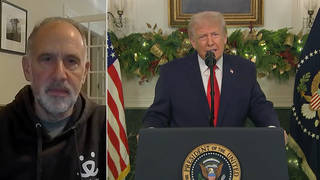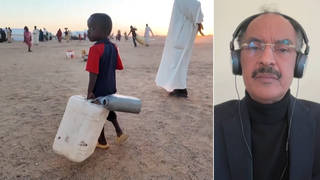
Democracy Now! producer Anjali Kamat files a report on the state of the Gazan economy, where unemployment and poverty rates are among the highest in the world. Despite international pledges of over $5.2 billion to rebuild Gaza, in the four months since Israel’s assault the siege has not been lifted and only one truck carrying cement and other construction materials has been allowed entry into the Gaza Strip. [includes rush transcript]
Report:
Transcript
AMY GOODMAN: We turn, though, now to, well, an international story, a report on the state of the Gazan economy, where unemployment and poverty rates are among the highest in the world. Despite international pledges of over $5.2 billion to rebuild Gaza, in the four months since Israel’s assault the siege has not been lifted and only one truck carrying cement and other construction materials has been allowed entry into the Gaza Strip. According to the Office for the Coordination of Humanitarian Affairs in the Occupied Palestinian Territories, this truck, which Israel permitted in late March, was the first carrying construction materials to be granted entry since last November.
Democracy Now!’s Anjali Kamat traveled to Gaza with Jacquie Soohen of Big Noise Films last month. She filed this story.
ANJALI KAMAT: Gaza is now a land of ruins. On December 27th, 2008, Israel launched a brutal twenty-two-day military operation in the Gaza Strip that killed over 1,400 Palestinians, the vast majority civilians. In addition to government and United Nations buildings, it is estimated that 21,000 homes were destroyed in all, leaving 100,000 people homeless. Over 600 industries and small businesses in Gaza were razed to the ground, sustaining $180 million in damages, according to the United Nations Development Program.
The industrial zone in Ezbat Abed Rabbo in northern Gaza once housed about sixty workshops and industries. Now it’s just a pile of rubble and twisted metal. Abu Omar established the Haddad tile factory and warehouse here just five years ago. During Israel’s latest assault on Gaza, he closed the factory and moved his family to the relative safety of Gaza City.
ABU OMAR: [translated] When we returned after the war, this is what we found. When we first came back, we couldn’t even recognize our neighborhood. It was like an earthquake, magnitude 10.0, not just 6.0. This is what we found. If there was any resistance, it must have been from here all the way to the Wafa hospital a mile and a half away. They didn’t spare a single house or factory or anything between here and the hospital. I consider this the result of an official decision by the Israeli government to destroy the entire area. We’ve incurred losses of $2,200,000.
ANJALI KAMAT: Salem Darraj used to work at a cement factory in the same area. Now, he too has joined the burgeoning ranks of the Palestinian unemployed, which some economists estimate has now risen to a staggering 70 percent in the Gaza Strip.
SALEM DARRAJ: [translated] There’s nothing going on here, as you can see. Everything is closed, the cars are stopped, the workers are unemployed, and everything is destroyed. As you can see, we are here guarding the businesses of the people we work for. We can’t just leave everything lying around in the open, but, at the same time, we can’t ask for our salaries.
ANJALI KAMAT: A quarter of Gaza’s population depended on agriculture for survival. Now, nearly half of the Strip’s agricultural land, infrastructure, and livestock and poultry farms are ravaged. The Food and Agriculture Organization estimates $268 million of losses to Gaza’s agriculture sector. Almost all of the 13,000 families reliant on farming, fishing and herding have been directly impacted.
We visited one such family in the Zaitoun neighborhood of Gaza City, where twenty-nine members of the Sammouni family were killed. Thirty-eight-year-old Naheela Sammouni and her husband were farmers. He was injured and buried alive in the Israeli attack, finally rescued from a pile of rubble and corpses four days after being given up for dead. He’s too weak to work, and his once lush farmland is now a devastated landscape.
NAHEELA SAMMOUNI: [translated] All of this is farmland. We used to grow chard, lettuce, turnips, radish, all from here. We’d sell it in the market and get some money to feed our children. Now our land is spoiled. Everything is destroyed. What can we do? We used to have sweet, tart pomegranates behind our home, so many plums, apricots, all right behind our house. Now, the olives, figs, everything is gone. We tended to our plants like our own children, so they would grow and we could eat from them. Now see what they did to us. What did we do wrong?
ANJALI KAMAT: Hamed Sammouni says the people of Zaitoun are simply too traumatized to go back to work.
HAMED SAMMOUNI: [translated] There’s absolutely no work. And even if there were jobs, people wouldn’t be able to work. People here are haunted by what happened and don’t have the mental capacity to work. After what they saw, they can’t work. Twenty-nine members of a single family gone. What’s left? What’s left?
Small children like these, what’s their fault? Do they have rockets? What do they know of resistance? An infant still breastfeeding from its mother, is he part of the resistance too? I mean, they even bombed chicken farms, too. How can chickens be in the resistance?
ANJALI KAMAT: John Ging, the head of the United Nations Relief and Works Agency, holds out little hope for reconstruction under these conditions.
JOHN GING: There’s going to be no reconstruction in Gaza until the crossing points open. There isn’t a bag of cement coming into Gaza at the moment. We have had to, you know, reopen our schools without conducting the repairs, because there is nothing — there’s no glass to fix the windows or do the basic repairs that are needed. We just have to make safe the area that is damaged and get on.
ANJALI KAMAT: But the economic devastation of Gaza did not begin with this latest assault that Israel dubbed “Operation Cast Lead.” Since 1967, Israel has maintained full control over Gaza’s borders. The restrictions grew tighter after Hamas won the elections in January 2006, and the blockade became a full-scale siege in June of 2007, when Hamas forces defeated those of rival Fatah, solidifying its control of the Gaza Strip.
Palestinian economist Omar Shabaan laid out the economic and political consequences of the siege, now in its twenty-second month.
OMAR SHABAAN: Since the closure in 2007, 95 percent of the Palestinian factories in Gaza closed down. We have 4,000 small businesses in Gaza. Two hundred thousand workers become unemployed in Gaza. And to make it clear to you, this 200,000 have no other option except joining the militia. They will become more radical. The siege, which was imposed by Israel, everybody knows now, it failed to bring any peace and moderation to the Palestinian society. This siege left Hamas with no competitors. Hamas is the only player in Gaza. So the international community should stop to blame us, and they should start to blame themselves for their own policy that they were imposing in Gaza.
JOHN GING: So, the siege is at the center of everything. It’s at the center of human misery. It’s at the center of violence. It’s at the center of desperation and a sense — a growing sense of hopelessness. So, you know, before this particular round of conflict, we had a situation where the economy had been destroyed under the siege; there was no commercial activity whatsoever. And the humanitarian effort just to sustain people with basic food and medicine and so on, this was a struggle. In fact, in November of last year, we ran out of food, because we weren’t able to get in sufficient quantities of food. For the first time in sixty years of UNRWA’s operation here, we actually ran out of food. We normally carry two months’ reserves, but we depleted all of our reserves, because we were getting in insufficient quantities to actually meet the demands. At that point, there were 750,000 refugees food-aid-dependent. Again, this is the inevitable consequences of having no economy.
ANJALI KAMAT: Today, over 1.1 million people in Gaza are dependent on international donations and agencies like UNRWA, UNICEF and the World Food Program. With all legal exit and entry points sealed by Israel and Egypt, the 1.4 million Palestinians squeezed into Gaza’s 140 square miles of land have been forced to turn underground for survival.
OMAR SHABAAN: The Israelis closed the whole border, so the Palestinian has no other option except to dig tunnels to Egypt to bring commodities and to bring some services.
ANJALI KAMAT: We decided to take a look at Gaza’s underground economy for ourselves and headed south to Rafah, where the air is thick with the buzz of US-made F-16s overhead. The tunnels lie below a very visible network of tents stretched along the border with Egypt. We lowered ourselves a hundred feet into a tunnel, which was still under construction. We spoke to the man running the motorized system bringing excess sand to the surface. He wouldn’t give us his name but told us why he risked his life working in the tunnels.
TUNNEL WORKER: [translated] This work is very difficult. But we have no choice. We have to work in order to eat. If the crossings were open and the goods and cement were coming in, there’s no way I would be doing this. If we work, we eat; if not, we go hungry. This is our only means, our only livelihood. As long as the crossings are closed, there’s no alternative to the tunnels.
ANJALI KAMAT: Before January, there were nearly a thousand tunnels along the border; now only 400 are operational. The tunnels have been the targets of deadly, almost daily air strikes by Israel, which accuses Hamas of using them to smuggle in weapons.
While the man we spoke with denied the tunnels are used to bring in weapons, there’s no denying that the tunnels serve as Gaza’s only conduit to the outside world. They bring in everything required to maintain a semblance of normal life — everything that Israel does not allow in through the crossings.
The downside is that the prices are near unaffordable for a majority of Palestinians. Daoud Al-Banna owns a grocery store in Rafah.
DAOUD AL-BANNA: [translated] The stores are full of goods from the tunnels, but at very high prices. Everything coming from the tunnels is very expensive. It’s all because of the siege, of course. If there was no siege, the prices would be normal. Prices used to be low, everything would be plentiful, and the goods would move off the shelves. Now, it’s the opposite. This used to be four shekels, now it’s nine shekels.
ANJALI KAMAT: Abu Omar from the Haddad tile factory said that cement in Gaza costs a fortune because it comes through the tunnels.
ABU OMAR: [translated] A bag of cement is about $4 everywhere in the world. We pay about $50, because cement in Gaza comes through the tunnels. We pay about $30 just for entry. Now the whole world wants to raise funds for Gaza, but can the world tell Israel to open the borders and let the goods come in for the people?
ANJALI KAMAT: A vendor at a wholesale market selling goods straight from the tunnels blamed the high prices on the continuing air strikes.
VENDOR: [translated] Now very few of the tunnels are functional, because the Israelis bomb the tunnels every day. Very few workers want to work there now. They’re scared. Also the Egyptians are cracking down on the tunnels bringing goods. Very few people come here to buy things, because everything is expensive, they aren’t getting salaries, and they just don’t have money to buy the goods.
ANJALI KAMAT: While the tunnels are the only lifeline into Gaza, they also leave Gazans vulnerable to Israeli air strikes. Umm Mohammad’s house is one of the few buildings left standing on the border with Egypt. Armored Caterpillar bulldozers demolished most of the other homes over five years ago, between 2000 and 2004. Tunnels now surround Umm Mohammad, and an air strike in early January damaged half her home.
UMM MOHAMMAD: [translated] There’s been no truce. There’s bombing every day. Just this morning, they bombed this tunnel. Yesterday here. Day before yesterday there. Every day, it’s a new place. Every day, there’s an attack. We’ve had to run out onto the streets each time they attack, once at 1:00 in the morning, once at noon, once in the middle of the afternoon. Every day, day after day.
ANJALI KAMAT: She pointed out another tunnel beside her house that she feared would be the next target.
UMM MOHAMMAD: [translated] There’s pros and cons to the tunnels. On the negative side, the tunnels put us in harm’s way. But we also benefit from them, because the crossings are closed. There’s no food or reconstruction or jobs. What are we supposed to do? The young men turn to this so they can get married, live, have children and eat.
ANJALI KAMAT: I asked her how prices had changed.
UMM MOHAMMAD: [translated] It is very expensive. Chicken is twenty-three shekels. Turkey is twenty-five. Meat is sixty. What do we do?
ANJALI KAMAT: A tunnel supervisor, who didn’t want his face on camera, said prices had to be high to keep the tunnels functioning.
TUNNEL SUPERVISOR: [translated] Everything is expensive. We have to pay rent to the tunnel owner, and there are a lot of expenses to keep the system working. It has to be expensive. There’s no official way into Gaza for items to be sold at regularized prices.
ANJALI KAMAT: Indeed the tunnels are now big business and constitute one of the only avenues for profitable investment.
OMAR SHABAAN: Since the closure, which was imposed on Gaza in June 2007, 90 percent of the products, what are available in Gaza market, were coming through the tunnels, and estimated the turnover of the tunnels around $30 to $40 million a month.
ANJALI KAMAT: But Omar Shabaan is critical of the kind of economy generated by the tunnels.
OMAR SHABAAN: We are very angry to be seen by the international community as tunnel diggers. We are a nation looking for peace, for a state, not to dig tunnels. We were obliged to dig tunnels to take food for our children. We, most of the Palestinians, are against that, because the tunnel has caused a huge trouble to our economy and to social fabrics. Some people become rich in two weeks. Some kids make $1, $2 million in three weeks. So the whole economy has become informal economy. Usually black economy, ten percent; the 90 percent is the legal one, registered, formal, pay taxes. But we have now 90 percent of our economy is the black market. We don’t know who’s bringing what and on what basis, what’s the criteria. The main thing here about this tunnel, this tunnel will create a group of people who will be against any peace, because peace means the end of the tunnel phenomenon. So the Israeli policy created some people in Gaza who are against the peace, against the truce.
ANJALI KAMAT: We asked the tunnel supervisor how his work is affected by the unity talks between Hamas and Fatah and international efforts for a peace process.
TUNNEL SUPERVISOR: [translated] If there’s an agreement or a solution or the crossings are opened, then all of this will have to close down, of course. None of this will remain as you see it now. But perhaps the smuggling — smuggling will never end in the world. Regardless of how much they try, it will not stop. There’s always something to smuggle.
ANJALI KAMAT: Putting a stop to cross-border smuggling into Gaza has become a key concern of the United States and other Western nations. Last month, the Obama administration pledged $900 million to rebuild Gaza on the condition that the Palestinian leadership renounce violence and recognize Israel’s right to exist. Meanwhile, the US has promised Israel $30 billion in aid over the next decade, 75 percent of which Israel must use to buy American military goods and services. Omar Shabaan remains skeptical about the impact of aid pledged to Palestinians.
OMAR SHABAAN: Mrs. Hillary Clinton knows exactly that the $900 million that the American government will help to the extent Gaza and the West Bank, it wouldn’t do any positive consequences unless the siege on Gaza is lifted. The siege on Gaza will not be lifted as long as Hamas is ruling Gaza. Hamas will not be — will continue to rule Gaza unless the Palestinian divide is coming to its end. The $5 billion pledges of the international community to help in Gaza cannot start, cannot flow into Gaza, because Hamas is here. The international community will not deal with Hamas directly. The international community will deal with PA in Ramallah. PA in Ramallah has no physical presence in Gaza. The international community knows exactly this problem. So they have to work harder to bring the Palestinians together, to pressure Israel to leave, to stop the siege, and to let the Palestinian economy operate.
ANJALI KAMAT: Some would argue, however, that the Palestinian economy hasn’t been allowed to operate for several years now. Israeli journalist Amira Hass says we have to go back to the 1990s, the decade of the Oslo peace process.
AMIRA HASS: Israel started its policy of closure in ’91, but it became more and more draconian and brutal when the PA, when the Palestinian Authority, was established in ’94. It went alongside it. And the main Israeli aim in that policy of closure was to separate Gaza from the West Bank, to disconnect the two.
This implied that less Palestinians could find work in Israel or could have worked in Israel. It, of course, affected their job opportunities here in Gaza. And it turned an entire people into beggars. We’re talking about one million and a half, excluding some bureaucrats and some politruks. They are more dependent than ever on outside sources than on themselves. And this is how I see the devastation of Gaza. It’s not the food that gets here. It’s not the — it’s their ability to decide about their life, even in — I mean, we don’t live in a world where people can really decide about their lives, but there are degrees. And they are now on the bottom of this ladder of how much you can decide about your life, you can improve your life, you can develop, you can offer your children a better life than your own life.
ANJALI KAMAT: While the people of Gaza try to rebuild their shattered lives, their primary demands are for the borders to be opened and guarantees that Israel will not destroy their homes and factories and farms once again. And many, like Abu Omar, the owner of the tile factory, don’t want monetary or humanitarian aid from the international community, but solidarity in their struggle for justice and accountability.
ABU OMAR: [translated] We don’t want to beg the world for money. We just want to take those who destroyed our houses to court. If we are really criminals and our houses are terrorist houses, then OK, this is what you get. But if our houses are innocent and our factories are innocent, then the Israelis need to account for what they destroyed. They are the ones who should give us the reparations. Why do we need to rely on the sympathy of the world? We don’t want that. We want the world to stand by our rights. We don’t want their charity, little bits of money and food. We’re full, thank God. We are just asking for our rights, nothing else.
ANJALI KAMAT: For Democracy Now!, this is Anjali Kamat with Jacquie Soohen, and special thanks to Hany Massoud and Fida Qishta.













Media Options